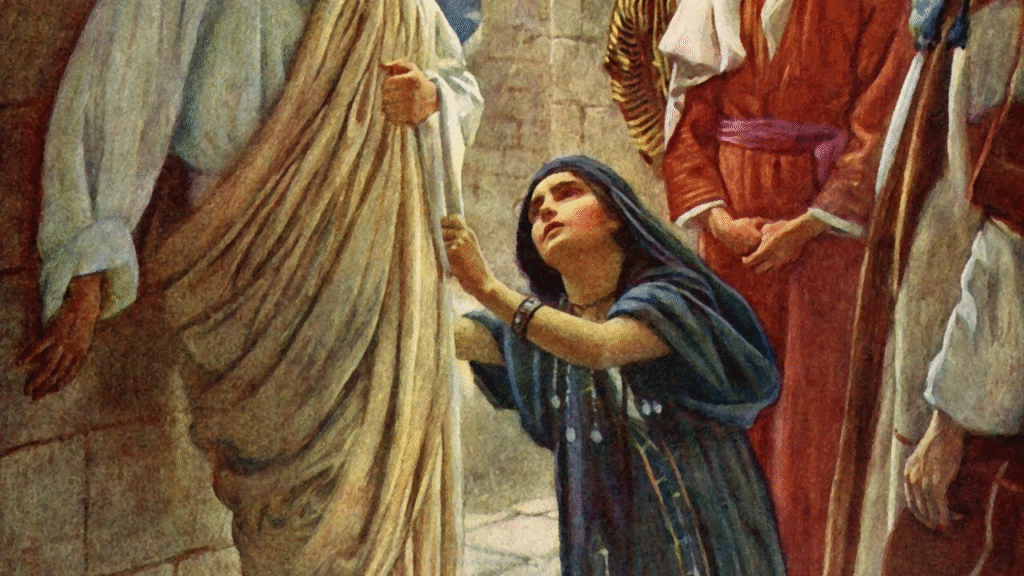The Women in the Jesus Bloodline

Five women are mentioned in the genealogy of Jesus Christ.
These women were both Jew and gentile, and their stories reveal:
- courage
- faith
- God’s plan for redemption
Mary
Mary was a first-century Jewish woman of Nazareth, the wife of Joseph and the mother of Jesus. She is an important figure of Christianity, venerated under various titles such as virgin or queen, many of them mentioned in the Litany of Loreto. The Eastern and Oriental Orthodox, Catholic, Anglican, Methodist, Reformed, Baptist, and Lutheran churches believe that Mary, as mother of Jesus, is the Mother of God.
Ruth
Ruth (/ruːθ/; Hebrew: רוּת, Modern: Rūt, Tiberian: Rūṯ) is the person after whom the Book of Ruth is named. She was a Moabite woman who married an Israelite, Mahlon. After the death of all the male members of her family (her husband, her father-in-law, and her brother-in-law), she stayed with her mother-in-law, Naomi, and moved to Judah with her, where Ruth won the love and protection of a wealthy relative, Boaz, through her kindness. She is the great-grandmother of David.
The story of Ruth as told in the Book of Ruth was likely written in Hebrew during the Persian period (550–330 BCE). Many scholars generally consider the book to be a work of historical fiction, while other scholars, including evangelical scholars, hold that it is a historical narrative written in the form of a short story.
Tamar
In the Book of Genesis, Tamar (/ˈteɪmər/; Hebrew: תָּמָר, Modern: Tamar pronounced [taˈmaʁ], Tiberian: Tāmār pronounced [tʰɔːˈmɔːr], date palm) was the daughter-in-law of Judah (twice), as well as the mother of two of his children: the twins Perez and Zerah.
Rahab
Rahab (/ˈreɪhæb/; Biblical Hebrew: רָחָב, romanized: Rāḥāḇ) was, according to the Hebrew Bible in Joshua 2:1-24, a Canaanite who resided within Jericho in the Promised Land and assisted the Israelites by hiding two men who had been sent to scout the city before their attack.
In the New Testament, she is lauded both as an example of a saint who lived by faith, and as someone “considered righteous” for her good works. According to biblical research, the author intended that she did not contribute to the fall of Jericho, but instead saved herself and her family from death at the hands of the Israelites.
The King James Version renders the name as Rachab after the Koine Greek spelling, which differs from the spelling for Rahab in the Epistle of James and the Epistle to the Hebrews. Most modern Bible translations render it as Rahab, ignoring the distinction.
Bathsheba
Bathsheba (/bæθˈʃiːbə, ˈbæθʃɪbə/; Hebrew: בַּת־שֶׁבַע Baṯ-šeḇaʿ, lit. ‘Daughter of Sheba’ or ‘Daughter of the Oath’) was an Israelite queen consort. According to the Hebrew Bible, she was the wife of Uriah the Hittite and later of David, with whom she had all of her five children. Her status as the mother of Solomon, who succeeded David as monarch, made her the Gebirah (גְּבִירָה) of the Kingdom of Israel. She is best known for her appearance in the Book of Samuel, which recounts how she was summoned by David’s royal messengers after he witnessed her bathing and lusted after her; David has Uriah killed and then marries Bathsheba, incurring the wrath of God, who strikes down the couple’s first child in infancy before plunging the House of David into chaos and anguish.
Bathsheba is mentioned in Jesus’ genealogy in Matthew.
Although she is not named, she is referred to as:
“the wife of Uriah the Hittite”
Bathsheba later conceived again and gave birth to Solomon, who is also part of Jesus’ lineage.
Uriah the Hittite (Hebrew: אוּרִיָּה הַחִתִּי ʾŪrīyyā haḤīttī) is a minor figure in the Hebrew Bible, mentioned in the Books of Samuel, an elite soldier in the army of David, king of Israel and Judah, and the husband of Bathsheba, the daughter of Eliam. While Uriah was serving in David’s army abroad, David, from the roof of his palace, looked down on his city and spied upon Bathsheba bathing in the privacy of her courtyard. Moved by lust at the sight of her, David called for Bathsheba to be brought to him and slept with her, impregnating her. In an effort to hide his misdeeds, David called Uriah home from war, hoping that he and Bathsheba would sleep with each other and that he would be able to pass the child off as belonging to Uriah. However, Uriah, being a disciplined soldier, refused to visit his wife. So David murdered him by proxy by ordering all of Uriah’s comrades to abandon him in the midst of battle, so that he ended up getting killed by an opposing army. Following Uriah’s death, David took Bathsheba as his eighth wife.
